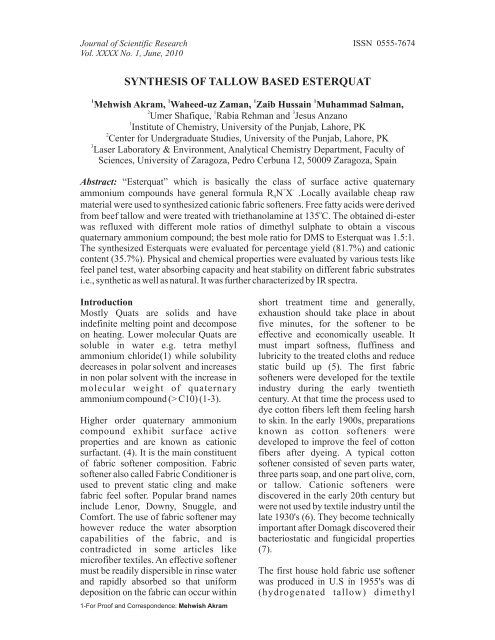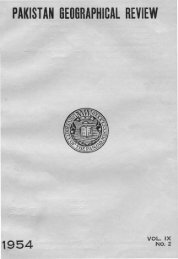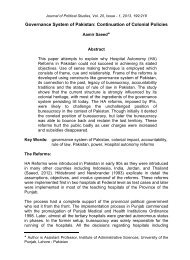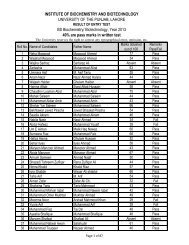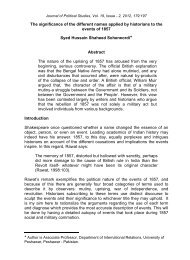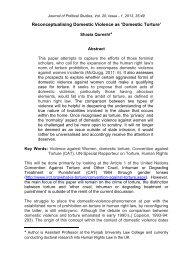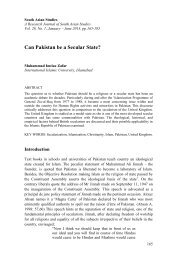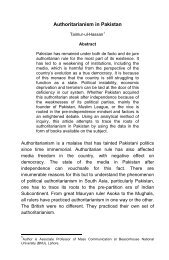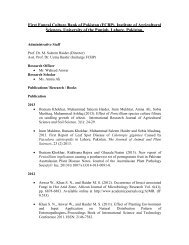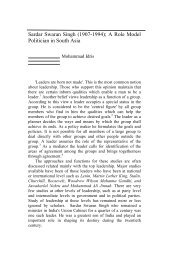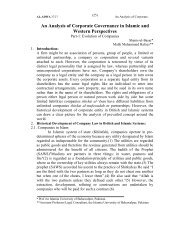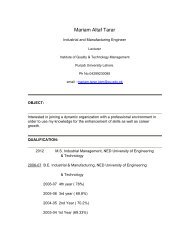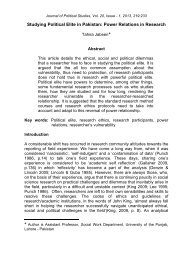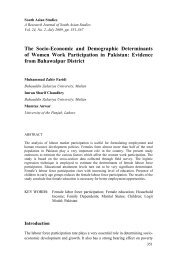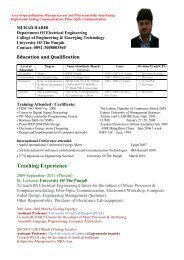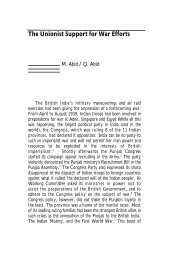Synthesis of Tallow Based Esterquat by Mehwish Akram
Synthesis of Tallow Based Esterquat by Mehwish Akram
Synthesis of Tallow Based Esterquat by Mehwish Akram
You also want an ePaper? Increase the reach of your titles
YUMPU automatically turns print PDFs into web optimized ePapers that Google loves.
Journal <strong>of</strong> Scientific Research<br />
Vol. XXXX No. 1, June, 2010<br />
SYNTHESIS OF TALLOW BASED ESTERQUAT<br />
ISSN 0555-7674<br />
1 1 1 1<br />
<strong>Mehwish</strong> <strong>Akram</strong>, Waheed-uz Zaman, Zaib Hussain Muhammad Salman,<br />
2 1 3<br />
Umer Shafique, Rabia Rehman and Jesus Anzano<br />
1<br />
Institute <strong>of</strong> Chemistry, University <strong>of</strong> the Punjab, Lahore, PK<br />
2<br />
Center for Undergraduate Studies, University <strong>of</strong> the Punjab, Lahore, PK<br />
3<br />
Laser Laboratory & Environment, Analytical Chemistry Department, Faculty <strong>of</strong><br />
Sciences, University <strong>of</strong> Zaragoza, Pedro Cerbuna 12, 50009 Zaragoza, Spain<br />
Abstract: “<strong>Esterquat</strong>” which is basically the class <strong>of</strong> surface active quaternary<br />
+ -<br />
ammonium compounds have general formula R4N X .Locally available cheap raw<br />
material were used to synthesized cationic fabric s<strong>of</strong>teners. Free fatty acids were derived<br />
o<br />
from beef tallow and were treated with triethanolamine at 135 C. The obtained di-ester<br />
was refluxed with different mole ratios <strong>of</strong> dimethyl sulphate to obtain a viscous<br />
quaternary ammonium compound; the best mole ratio for DMS to <strong>Esterquat</strong> was 1.5:1.<br />
The synthesized <strong>Esterquat</strong>s were evaluated for percentage yield (81.7%) and cationic<br />
content (35.7%). Physical and chemical properties were evaluated <strong>by</strong> various tests like<br />
feel panel test, water absorbing capacity and heat stability on different fabric substrates<br />
i.e., synthetic as well as natural. It was further characterized <strong>by</strong> IR spectra.<br />
Introduction short treatment time and generally,<br />
Mostly Quats are solids and have exhaustion should take place in about<br />
indefinite melting point and decompose five minutes, for the s<strong>of</strong>tener to be<br />
on heating. Lower molecular Quats are effective and economically useable. It<br />
soluble in water e.g. tetra methyl must impart s<strong>of</strong>tness, fluffiness and<br />
ammonium chloride(1) while solubility lubricity to the treated cloths and reduce<br />
decreases in polar solvent and increases static build up (5). The first fabric<br />
in non polar solvent with the increase in s<strong>of</strong>teners were developed for the textile<br />
molecular weight <strong>of</strong> quaternary industry during the early twentieth<br />
ammonium compound (> C10) (1-3). century. At that time the process used to<br />
dye cotton fibers left them feeling harsh<br />
Higher order quaternary ammonium to skin. In the early 1900s, preparations<br />
compound exhibit surface active known as cotton s<strong>of</strong>teners were<br />
properties and are known as cationic developed to improve the feel <strong>of</strong> cotton<br />
surfactant. (4). It is the main constituent fibers after dyeing. A typical cotton<br />
<strong>of</strong> fabric s<strong>of</strong>tener composition. Fabric s<strong>of</strong>tener consisted <strong>of</strong> seven parts water,<br />
s<strong>of</strong>tener also called Fabric Conditioner is three parts soap, and one part olive, corn,<br />
used to prevent static cling and make or tallow. Cationic s<strong>of</strong>teners were<br />
fabric feel s<strong>of</strong>ter. Popular brand names discovered in the early 20th century but<br />
include Lenor, Downy, Snuggle, and were not used <strong>by</strong> textile industry until the<br />
Comfort. The use <strong>of</strong> fabric s<strong>of</strong>tener may late 1930's (6). They become technically<br />
however reduce the water absorption important after Domagk discovered their<br />
capabilities <strong>of</strong> the fabric, and is bacteriostatic and fungicidal properties<br />
contradicted in some articles like (7).<br />
micr<strong>of</strong>iber textiles. An effective s<strong>of</strong>tener<br />
must be readily dispersible in rinse water The first house hold fabric use s<strong>of</strong>tener<br />
and rapidly absorbed so that uniform was produced in U.S in 1955's was di<br />
deposition on the fabric can occur within (hydrogenated tallow) dimethyl<br />
1-For Pro<strong>of</strong> and Correspondence: <strong>Mehwish</strong> <strong>Akram</strong>
<strong>Mehwish</strong> <strong>Akram</strong><br />
ammonium chloride (8). S<strong>of</strong>teners were an effective fabric conditioner. (14)<br />
introduced about 10 years later in Europe<br />
(9-10) Triethanolamine (TEA)-based <strong>Esterquat</strong>s are generally prepared <strong>by</strong><br />
esterquat has been the primary ingredient reaction <strong>of</strong> two mole <strong>of</strong> tallow fatty acid<br />
in European fabric s<strong>of</strong>teners for several and one mole <strong>of</strong> triethanolamine then the<br />
years and is becoming the global diester was quarernized <strong>by</strong> (dimethyl<br />
molecule <strong>of</strong> choice. Although it has an sulfate)DMS.<br />
excellent environmental pr<strong>of</strong>ile, TEA<br />
esterquat has been plagued <strong>by</strong> mediocre Material and methods<br />
performance compared to historical All the chemical used for the synthesis <strong>of</strong><br />
molecules such as dihydrogenated tallow Diester and <strong>Esterquat</strong> were <strong>of</strong> chemical<br />
dimethyl ammonium chloride and grade.<br />
ditallow imidazoline quat. (11)<br />
Apparatus<br />
Beside anionic, silicon and non ionic Rotary evaporator with Chiller, Burette,<br />
fabric s<strong>of</strong>tener mostly cationic fabric pipette, round bottom flask, stirring hot<br />
s<strong>of</strong>tener are commonly used. The fabric plate with Teflon follower.<br />
s<strong>of</strong>teners are called cationic because the<br />
positive charged hydrophilic parts are Experimental work<br />
predominant in the rinse water when 1. Isolation <strong>of</strong> free fatty acid from<br />
cationic s<strong>of</strong>teners are added. Major area tallow<br />
<strong>of</strong> cotton fabric is negatively charged, so For the preparation <strong>of</strong> free fatty acids<br />
all the cations are picked up <strong>by</strong> the fabric various steps were performed. In the first<br />
and are retained on the fabric during the step saponification <strong>of</strong> tallow was<br />
rinsing process when fabric s<strong>of</strong>teners are calculated. For this 0.9 g <strong>of</strong> soap was<br />
applied. The hydrophobic part <strong>of</strong> fatty taken in 250ml volumetric flask and was<br />
hydrocarbons is the agent that causes dissolved in small amount <strong>of</strong><br />
cationic s<strong>of</strong>teners to s<strong>of</strong>ten the fibers in isopropanol. 2 drops <strong>of</strong> phenolphthalein<br />
fabric (12) was added as indicator. It was titrated<br />
with 0.1N alcoholic KOH with constant<br />
Beside the fabric s<strong>of</strong>tening the <strong>Esterquat</strong> shaking until pink color produced which<br />
commonly form the foundation <strong>of</strong> persisted for 15 seconds.<br />
formulations in the antimicrobial<br />
industry. Many studies have been 100g <strong>of</strong> tallow was weighed and was<br />
conducted on the biological activity <strong>of</strong> heated in beaker on hot plate until it was<br />
surfactants derived from fatty acids viz. melted. Then 50% sodium hydroxide<br />
lauric acid, myristic acid, stearic acid and solution was added in it maintaining the<br />
palmitic acid and palm fatty acid with temperature at 105°C, alkali was added<br />
polyamine, i.e. 1(2-hydroxyethylpi- in little excess until there was no increase<br />
perazine). (13) in free fatty acid content.<br />
The inclusion <strong>of</strong> ester linkages into the<br />
aliphatic chains has significantly<br />
improved the kinetics <strong>of</strong> biodegradation<br />
<strong>of</strong> the cationic surfactants, lowering the<br />
environmental exposure levels. This new<br />
generation <strong>of</strong> fabric s<strong>of</strong>tening agents<br />
combines a good environmental pr<strong>of</strong>ile<br />
with the structural features required for<br />
32<br />
H<br />
O<br />
H C O C<br />
O<br />
H C O C<br />
O<br />
H C O C<br />
H<br />
Na +<br />
Na +<br />
Na +<br />
R1<br />
R2<br />
R 3<br />
NaOH<br />
O<br />
-<br />
O C R1<br />
O<br />
-<br />
O C R2<br />
O<br />
- O C R3<br />
H<br />
H<br />
H<br />
H<br />
C<br />
C<br />
C<br />
H<br />
O<br />
O<br />
O<br />
+
The acid hydrolysis <strong>of</strong> prepared soap was 250 ml round bottom flask. Thermometer<br />
performed and for this glycerin was was inserted in one neck <strong>of</strong> flask and<br />
removed. Soap was stirred with condenser was fitted on other neck.<br />
sufficient amount <strong>of</strong> water until to get When the diester was completely<br />
honey consistency. Mechanical stirrer dissolved in it, then 1.5mole <strong>of</strong> dimethyl<br />
was used in this operation. In this way a sulphate (3.65 g) was added drop <strong>by</strong> drop<br />
uniform sticky solution was formed. It with constant stirring at 70 °C. Reaction<br />
was treated with 7N HCl solution to get mixture was stirred for 2 hour. <strong>Esterquat</strong><br />
highly acidic pH. The upper free fatty contents were transferred to a beaker and<br />
acids were decented. The free fatty acids the petroleum ether was evaporated<br />
were <strong>of</strong>f-white in appearance. The acid heating on water bath until a viscous<br />
value <strong>of</strong> free fatty acid was calculated <strong>by</strong> compound was obtained. It was then<br />
standard method. weighed. Similarly 1.75mole (3.9g) and<br />
2 mole (4.15 g) <strong>of</strong> dimethyl sulphate<br />
2. Preparation <strong>of</strong> diester <strong>of</strong> tallow fatty were reacted with diester to form the<br />
acid esterquat.a<br />
100g <strong>of</strong> free fatty acid was taken in the<br />
evaporating flask <strong>of</strong> rotary evaporator.<br />
Then 17.5g triethanolamine (1 mole) and<br />
1ml <strong>of</strong> sodium methoxide was added in<br />
it. The temperature <strong>of</strong> paraffin oil bath<br />
O<br />
was adjusted at 135 C. The temperature<br />
<strong>of</strong> cooling fluid circulating in condenser<br />
O Characterization <strong>of</strong> fabric s<strong>of</strong>tener<br />
wall was set at 5 C. 25mmHg vacuum<br />
was created in the reaction assembly to<br />
remove the water. The acid value was<br />
checked after half an hour. The reaction<br />
was continued until its acid value reached<br />
6.02.<br />
In varying the above experiment<br />
orthophosporic acid was used instead <strong>of</strong><br />
sodium methoxide using the above<br />
assembly. The reaction was continued<br />
until its acid value reached 5.6.<br />
2 R<br />
O<br />
OH<br />
+<br />
HO<br />
N<br />
OH<br />
OH<br />
- 2H 2 O<br />
Free fatty acid triethanolamine diester <strong>of</strong> triethanolamine<br />
3. <strong>Esterquat</strong> <strong>Synthesis</strong><br />
By considering the alkyl chain <strong>of</strong> free<br />
fatty acid mainly <strong>of</strong> C-18 diester <strong>of</strong><br />
triethanolamine was treated with<br />
different mole ratios <strong>of</strong> dimethyl sulphate<br />
to produce <strong>Esterquat</strong>. For this 1 mole <strong>of</strong><br />
diester <strong>of</strong> triethanolamine (20g) was<br />
dissolved in 50ml <strong>of</strong> petroleum ether in<br />
HO<br />
N<br />
O<br />
O<br />
R<br />
O<br />
R<br />
O<br />
33<br />
HO<br />
N<br />
O<br />
<strong>Synthesis</strong> <strong>of</strong> <strong>Tallow</strong> <strong>Based</strong> <strong>Esterquat</strong><br />
O<br />
R<br />
O<br />
R<br />
+ (CH 3 ) 2 SO 4<br />
O<br />
Diester <strong>of</strong> Triethanolamine EsterQuat<br />
1. Sodium Lauryl Sulphate (0.004M)<br />
1.464 g <strong>of</strong> Sodium Lauryl Sulphate was<br />
dissolved in 1000 ml <strong>of</strong> distilled water to<br />
make 0.004M solution <strong>of</strong> Sodium Lauryl<br />
Sulphate.<br />
2. Methylene Blue (0.003%)<br />
0.003g <strong>of</strong> Methylene blue was dissolved<br />
in 100 ml <strong>of</strong> distilled water to make<br />
0.003% solution.<br />
3. <strong>Esterquat</strong> Solution (0.004M)<br />
0.004 M solution <strong>of</strong> <strong>Esterquat</strong> was<br />
prepared. <strong>Esterquat</strong> was dissolved in 20<br />
ml <strong>of</strong> Ethanol and made the volume up to<br />
mark <strong>of</strong> 250 ml.<br />
Determination <strong>of</strong> cationic content<br />
10ml <strong>of</strong> Standard Sodium Lauryl<br />
Sulphate was taken in 250ml stoppered<br />
flask and 5 ml <strong>of</strong> 0.003% methylene blue<br />
was added followed <strong>by</strong> 0. 2ml<br />
concentrated H2SO 4,<br />
5g anhydrous<br />
Sodium Sulphate and 15 ml Chlor<strong>of</strong>orm.<br />
HO<br />
N +<br />
CH 3<br />
O<br />
O<br />
R<br />
O<br />
R<br />
O<br />
-<br />
CH3SO4
<strong>Mehwish</strong> <strong>Akram</strong><br />
After gentle shaking, flask was allowed C 1 = M o r a l i t y o f E s t e r q u a t<br />
to stand for 10 minute until the two layers<br />
s e p a r a t e d , t h e o r g a n i c l a y e r<br />
C2 =Morality <strong>of</strong> Sodium Lauryl Sulphate<br />
V1 = Volume <strong>of</strong> <strong>Esterquat</strong> used from burette<br />
(Cholor<strong>of</strong>orm) was blue coloured. It was<br />
titrated with 0.004M solution <strong>of</strong><br />
Esterqaut and at end point the both the<br />
layers had same intensity <strong>of</strong> colour.<br />
Solubility <strong>of</strong> fabric s<strong>of</strong>tener<br />
Solubility <strong>of</strong> synthesized esterquat<br />
Calculation<br />
Molarity <strong>of</strong> EsterQuat C1 =<br />
(fabric s<strong>of</strong>tener) was checked using<br />
different solvents and results arereported<br />
in table.<br />
10C2<br />
Cationic Content =<br />
C1 X Molecular weight <strong>of</strong> <strong>Esterquat</strong><br />
Weight <strong>of</strong> sample X 4<br />
X 100<br />
V1<br />
Table 1: Solubility effect <strong>of</strong> solvent on esterquat<br />
Solvent Fabric s<strong>of</strong>tener<br />
Isopropanol Soluble<br />
Hot water<br />
Coldwater<br />
Chlor<strong>of</strong>orm<br />
Ethanol<br />
n-Hexane<br />
Dimethyl sulphoxide<br />
Petroleum ether<br />
Acetone<br />
Methanol<br />
Carbon tetrachloride<br />
34<br />
Sparingly soluble<br />
Slightly soluble<br />
Soluble<br />
Soluble<br />
Soluble<br />
Sparingly soluble<br />
Soluble<br />
Insoluble<br />
Insoluble<br />
Soluble<br />
Compatibility <strong>of</strong> fabric S<strong>of</strong>tener with 3. Heat Stability<br />
natural and synthetic fabrics Pieces <strong>of</strong> cloths treated with the s<strong>of</strong>teners<br />
1. S<strong>of</strong>tener solutions were placed in to oven at 150oC<br />
Different concentrations <strong>of</strong> <strong>Esterquat</strong> for one minutes. The s<strong>of</strong>tener still had<br />
(5% and 3%) were prepared and pieces <strong>of</strong> well s<strong>of</strong>tness effect on cloths.<br />
cotton cloths was treated with fabric<br />
s<strong>of</strong>tener and found that s<strong>of</strong>teners gave 4. Water Absorbing<br />
good handling and impart greater It was revealed that the s<strong>of</strong>tener had no<br />
s<strong>of</strong>tness than the cloths which were not effect on absorption power <strong>of</strong> towel<br />
s<strong>of</strong>tened. treated with fabric s<strong>of</strong>tener.<br />
Weight <strong>of</strong> untreated towel cloths =<br />
2. Weight test 0.40gm<br />
Weight <strong>of</strong> untreated cloths = 0.358gm Weight <strong>of</strong> treated towel cloths =<br />
Weight <strong>of</strong> treated cloths = 0.425gm 0.450gm<br />
Weight gain <strong>by</strong> s<strong>of</strong>tening treatment = Weight gain <strong>by</strong> s<strong>of</strong>tening treatment =<br />
0.067gm (18.7%) 0.05gm (12.5%)
Result and Discussion in the second step <strong>of</strong> synthesis, a pale<br />
<strong>Esterquat</strong> constitute an important class <strong>of</strong> yellow semi solid product was obtained.<br />
cationic surfactant. The main object <strong>of</strong> The quaternization <strong>of</strong> diesterquat was<br />
O<br />
research work was to synthesized carried out at 60-70 C. Diester was<br />
esterquat from cheap, indiginous stirred for 2- hours with different mole<br />
materials which should work as fabric ratio <strong>of</strong> DMS to obtained <strong>Esterquat</strong>. The<br />
s<strong>of</strong>tener. The prepared <strong>Esterquat</strong> gave the result indicated that quaternization <strong>of</strong><br />
appreciable result. diester for 2 hr using 1:1.50 molar ratio <strong>of</strong><br />
In the two step synthesis <strong>of</strong> <strong>Esterquat</strong>, the diester <strong>of</strong> triethanolamine to DMS give<br />
product obtained in the first step, which better yield <strong>of</strong> <strong>Esterquat</strong>.<br />
involve diester formation from tallow<br />
free fatty acids and triethanolamine, Table 4: Reaction parameters and<br />
represented a characteristic colour results<br />
change. The acid value <strong>of</strong> free fatty acids<br />
(208) were calculated<br />
Table2: Characteristic <strong>of</strong> tallow<br />
characteristic value<br />
Saponification value 256<br />
35<br />
Alkylation was an exothermic reaction<br />
and temperature <strong>of</strong> ester rose about 4-50<br />
C after addition <strong>of</strong> dimethyl sulphate, so<br />
its was added slowly. Alkylation<br />
lightened the color <strong>of</strong> <strong>Esterquat</strong> to some<br />
Initially the acid value <strong>of</strong> condensate extent. <strong>Esterquat</strong> was insoluble in warm<br />
(Diester formation) decreased rapidly water. Emulsifiers were needed to<br />
because water <strong>of</strong> condensation being dissolve in water. The reason being long<br />
removed from mixture promptly under chain fatty acids resist the solubility.<br />
the influence <strong>of</strong> vaccum. Orthophosporic<br />
acid was found to be a better catalyst for Structure <strong>of</strong> product was confirmed on<br />
this reaction. . The lowest value (5.6) <strong>of</strong> the basis <strong>of</strong> IR spectroscopic data. This<br />
O<br />
Diester was obtained at 135 C with was made <strong>by</strong> comparing IR spectra <strong>of</strong><br />
orthophosphoric acid. The advantage <strong>of</strong> reactant and products. The stretching<br />
this method was that product was light in vibration and OH deformation <strong>of</strong><br />
colour and diester was formed within <strong>Esterquat</strong> were indicated <strong>by</strong> the peaks at<br />
-1<br />
short interval <strong>of</strong> time as compared to 3437and 1094 cm respectively. These<br />
sodium methoxide method where the two peaks were the confirmation <strong>of</strong> free<br />
product became darker in that case and it OH <strong>of</strong> diester <strong>of</strong> triethanolamine and<br />
was very lengthy procedure. tallow fatty acids. The CH group in<br />
2<br />
-1<br />
esterquat gave peak at 2914 cm . The<br />
Table 3: Diester <strong>of</strong> <strong>Tallow</strong> fatty acid tertiary nitrogen gave peak at 2857 cm<br />
-1<br />
and 1644.4 cm .<br />
<strong>Tallow</strong> fatty<br />
acid<br />
Free fatty acid 208<br />
Catalyst<br />
Sodium methoxide<br />
Orthophosphoric acid<br />
Diester yield<br />
72.54%<br />
81.55%<br />
In the diester all peaks <strong>of</strong> <strong>Esterquat</strong> were<br />
-1<br />
present except <strong>of</strong> peaks at 1004.2 cm ,<br />
757 cm-1, 826 cm-1. These peaks were<br />
obtained because <strong>Esterquat</strong> contained<br />
When reaction was preceded <strong>by</strong> CH SO ion so there were S = O<br />
3 4<br />
quaternization <strong>of</strong> diester with different<br />
mole ratio <strong>of</strong> dimethyl sulphate solution<br />
<strong>Synthesis</strong> <strong>of</strong> <strong>Tallow</strong> <strong>Based</strong> <strong>Esterquat</strong><br />
Sr No Diester: DMS Temperature Cationic Content<br />
1 1:1.5 2h 35.7 %<br />
Yield<br />
81.3%<br />
2 1:1.75 2h 28.5 % 77%<br />
3 1:2 2h 25% 72.5%<br />
stretching vibration present in <strong>Esterquat</strong><br />
-1
<strong>Mehwish</strong> <strong>Akram</strong><br />
determination. More over the peaks at 132, 1996.<br />
1466.4 confirmed the Quaternary 6. Dubrow PL, Khanna WM. Soap<br />
nitrogen <strong>of</strong> <strong>Esterquat</strong>.<br />
Table 5: INTERPRETATION OF IR<br />
and chemical Specialties, 33:89-<br />
97, 1957.<br />
SPECTRUM<br />
Appearance <strong>of</strong> characteristic peaks on<br />
IR spectrum <strong>of</strong> <strong>Esterquat</strong> confirmed it<br />
7. D o m a g k G . D t s h . M e d .<br />
Wochenscher, 21:829, 1953<br />
structure.<br />
Group Frequency <strong>of</strong> Diester <strong>of</strong><br />
-1<br />
triethanolamine (cm )<br />
Frequency <strong>of</strong> Ester<br />
-1<br />
Quat (cm )<br />
8. Egan RR. J.Am.Oil Chem. Soc,<br />
55:118-121, 1978.<br />
O-H Stretching<br />
O-H Deformation<br />
3354 3437<br />
1094 1058<br />
C==O 1737 1727<br />
C---O 1173 1177<br />
Tertiary N 2850, 1629 2857, 1644.4<br />
S==O 1004.2, 757, 826<br />
CH2 2918 2914<br />
Quaternary N +<br />
1466.4<br />
36<br />
9. Ward HL. Journal <strong>of</strong> home<br />
Economics, 49:122-123, 1957.<br />
10. Mullin R. Journal <strong>of</strong> Soaps and<br />
Detergent, 150:24, 1992.<br />
11. Friedli FE, KoehleH.J, Fender<br />
M, Watts M, Keys R., Frank P,<br />
Toney C.J, Doerr M. Journal <strong>of</strong><br />
References Surfactants and Detergents,<br />
5:211-216, 2002.<br />
1. Shelton R J. Am.Chem.Soc,<br />
66:753, 1946. 12. Mcnally JP, Mccord FA. Journal<br />
<strong>of</strong> Textile, 30:715, 1960.<br />
2. Reck R, Harwood H, Ralston H.<br />
J.Org.Chem, 12:517, 1947. 13. Mishra S, Tyagi V K. Journal <strong>of</strong><br />
Surfactants and Detergents,<br />
3. Ralston A. J.Org.Chem, 13:186, 11:167-173, 2008.<br />
1948.<br />
14. Mishra, S, Tyagi V K. Journal <strong>of</strong><br />
4. Jungermann E. Cationic Oleo Science, 56:269-276,<br />
Surfactant, Markeel Dekker, 2007.<br />
Inc.New York, 1969.<br />
5. Shenai VA, Mehra RH.<br />
Te c h n o l o g y o f Te x t i l e<br />
Processing, 2nd ed. Sevak<br />
Publication: Bombay, PP.128-


